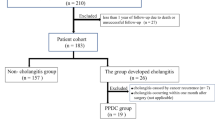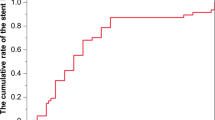Abstract
Background
Postoperative cholangitis is one of the major late complications after pancreaticoduodenectomy (PD), and recurrent cholangitis has a negative impact on patients’ quality of life. However, detailed reports are scarce. The aim of this study was to investigate the clinical features of postoperative cholangitis after PD.
Methods
Between January 2007 and December 2013, 155 consecutive patients underwent PD. Of these, 113 patients were included in this study. Cholangitis was diagnosed according to the criteria in the revised Tokyo Guidelines 2013, and repeated cholangitis with three or more episodes was defined as ‘refractory cholangitis’. Data from patients with refractory cholangitis were retrospectively analyzed.
Results
Refractory cholangitis was observed in 21 patients (18.6%). Of these, 17 patients experienced cholangitis within 1 year after PD, and 10 patients had biliary strictures. These patients required an average of two interventional or endoscopic treatments for stricture dilatation, which led to remission. The 2-year cumulative incidence rate for refractory cholangitis was 18.9% (95% CI 11.65–26.15). Multivariate analysis revealed five risk factors for developing refractory cholangitis: benign disease (odds ratio [OR] 18.52; P = 0.001), long operation time (OR 18.73; P = 0.002), elevated C-reactive protein (OR 6.55; P = 0.014), elevated alkaline phosphatase (OR 6.03; P = 0.018), and the presence of pneumobilia (OR 28.81; P = 0.009).
Conclusions
Postoperative refractory cholangitis after PD usually developed within a year. Almost half of the patients had biliary strictures, and aggressive dilatation might be effective to achieve remission in these patients.



Similar content being viewed by others
References
Cameron JL, He J (2015) Two thousand consecutive pancreaticoduodenectomies. J Am Coll Surg 220:530–536
Ahmad SA, Edwards MJ, Sutton JM et al (2012) Factors influencing readmission after pancreaticoduodenectomy: a multi-institutional study of 1302 patients. Ann Surg 256:529–537
Yeo CJ, Cameron JL, Sohn TA et al (1997) Six hundred fifty consecutive pancreaticoduodenectomies in the 1990s: pathology, complications, and outcomes. Ann Surg 226:248–257 (discussion 257–260)
Amini N, Spolverato G, Kim Y et al (2015) Trends in hospital volume and failure to rescue for pancreatic surgery. J Gastrointest Surg 19:1581–1592
Kimura W, Miyata H, Gotoh M et al (2014) A pancreaticoduodenectomy risk model derived from 8575 cases from a national single-race population (Japanese) using a web-based data entry system: the 30-day and in-hospital mortality rates for pancreaticoduodenectomy. Ann Surg 259:773–780
Keck T, Wellner UF, Bahra M et al (2016) Pancreatogastrostomy versus pancreatojejunostomy for RECOnstruction after PANCreatoduodenectomy (RECOPANC, DRKS 00000767): perioperative and long-term results of a multicenter randomized controlled trial. Ann Surg 263:440–449
Prawdzik C, Belyaev O, Chromik AM et al (2015) Surgical revision of hepaticojejunostomy strictures after pancreatectomy. Langenbecks Arch Surg 400:67–75
Kang CM, Lee JH (2015) Pathophysiology after pancreaticoduodenectomy. World J Gastroenterol 21:5794–5804
Nomura R, Ishizaki Y, Suzuki K et al (2007) Development of hepatic steatosis after pancreatoduodenectomy. Am J Roentgenol 189:1484–1488
House MG, Cameron JL, Schulick RD et al (2006) Incidence and outcome of biliary strictures after pancreaticoduodenectomy. Ann Surg 243:571–576 (discussion 576–578)
Duconseil P, Turrini O, Ewald J et al (2014) Biliary complications after pancreaticoduodenectomy: skinny bile ducts are surgeons’ enemies. World J Surg 38:2946–2951
Yamaguchi K, Tanaka M, Chijiiwa K et al (1999) Early and late complications of pylorus-preserving pancreatoduodenectomy in Japan 1998. J Hepatobiliary Pancreat Surg 6:303–311
Janbain M, Leissinger CA, Kruse-Jarres R (2015) Acquired hemophilia A: emerging treatment options. J Blood Med 6:143–150
Wada K, Takada T, Kawarada Y et al (2007) Diagnostic criteria and severity assessment of acute cholangitis: Tokyo guidelines. J Hepatobiliary Pancreat Surg 14:52–58
Kiriyama S, Takada T, Strasberg SM et al (2012) New diagnostic criteria and severity assessment of acute cholangitis in revised Tokyo guidelines. J Hepatobiliary Pancreat Sci 19:548–556
Kimura W (2008) Strategies for the treatment of invasive ductal carcinoma of the pancreas and how to achieve zero mortality for pancreaticoduodenectomy. J Hepatobiliary Pancreat Surg 15:270–277
Friess H, Ho CK, Kleef J et al (2007) Pancreaticoduodenectomy, distal pancreatectomy, segmental pancreatectomy, total pancreatectomy, and transduodenal resection of the papilla of Vater. In: Surgery of the liver, biliary tract, and pancreas. Saunders, Philadelphia, pp 877–903
Fujii T, Sugimoto H, Yamada S et al (2014) Modified Blumgart anastomosis for pancreaticojejunostomy: technical improvement in matched historical control study. J Gastrointest Surg 18:1108–1115
Bassi C, Dervenis C, Butturini G et al (2005) Postoperative pancreatic fistula: an international study group (ISGPF) definition. Surgery 138:8–13
Wente MN, Bassi C, Dervenis C et al (2007) Delayed gastric emptying (DGE) after pancreatic surgery: a suggested definition by the International Study Group of Pancreatic Surgery (ISGPS). Surgery 142:761–768
Wente MN, Bassi C, Dervenis C et al (2007) Postpancreatectomy hemorrhage (PPH): an International Study Group of Pancreatic Surgery (ISGPS) definition. Surgery 142:20–25
Koch M, Garden OJ, Padbury R et al (2011) Bile leakage after hepatobiliary and pancreatic surgery: a definition and grading of severity by the International Study Group of Liver Surgery. Surgery 149:680–688
Westerkamp AC, Korkmaz KS, Bottema JT et al (2015) Elderly donor liver grafts are not associated with a higher incidence of biliary complications after liver transplantation: results of a national multicenter study. Clin Transplant 29:636–643
Higuchi R, Takada T, Strasberg SM et al (2013) TG13 miscellaneous etiology of cholangitis and cholecystitis. J Hepatobiliary Pancreat Sci 20:97–105
Reid-Lombardo KM, Ramos-De la Medina A, Thomsen K et al (2007) Long-term anastomotic complications after pancreaticoduodenectomy for benign diseases. J Gastrointest Surg 11:1704–1711
Chuang JH, Lee SY, Chen WJ et al (2001) Changes in bacterial concentration in the liver correlate with that in the hepaticojejunostomy after bile duct reconstruction: implication in the pathogenesis of postoperative cholangitis. World J Surg 25:1512–1518
Tsalis K, Antoniou N, Koukouritaki Z et al (2014) Successful treatment of recurrent cholangitis by constructing a hepaticojejunostomy with long Roux-en-Y limb in a long-term surviving patient after a Whipple procedure for pancreatic adenocarcinoma. Am J Case Rep 15:348–351
Vrochides D, Fischer SA, Soares G et al (2007) Successful treatment of recurrent cholangitis complicating liver transplantation by Roux-en-Y limb lengthening. Transpl Infect Dis 9:327–331
Sanada Y, Yamada N, Taguchi M et al (2014) Recurrent cholangitis by biliary stasis due to non-obstructive afferent loop syndrome after pylorus-preserving pancreatoduodenectomy: report of a case. Int Surg 99:426–431
Bonnel DH, Fingerhut AL (2012) Percutaneous transhepatic balloon dilatation of benign bilioenteric strictures: long-term results in 110 patients. Am J Surg 203:675–683
Ammori BJ, Joseph S, Attia M et al (2000) Biliary strictures complicating pancreaticoduodenectomy. Int J Pancreatol 28:15–21 (discussion 21–22)
Sherman SC, Tran H (2006) Pneumobilia: benign or life-threatening. J Emerg Med 30:147–153
Mortelé KJ, Lemmerling M, de Hemptinne B et al (2000) Postoperative findings following the Whipple procedure: determination of prevalence and morphologic abdominal CT features. Eur Radiol 10:123–128
Gutknecht DR (2001) Cholangitis and pneumobilia after a Whipple procedure. Am J Emerg Med 19:87–88
Acknowledgements
We would like to thank the radiologists and gastroenterologists at our hospital who greatly contributed to the clinical diagnosis and treatment of cholangitis in this study.
Author information
Authors and Affiliations
Corresponding author
Ethics declarations
Conflict of interest
The authors declare that they have no conflict of interest.
Additional information
Meeting presentation information: Presented as a poster presentation at the Society for Surgery of the Alimentary Tract poster session (Poster ID: Tu1504) in Digestive Disease Week 2016, May 24, 2016, San Diego, California, and at the 50th Annual Pancreas Club poster session (Poster ID: P073), May 20, 2016, San Diego, California.
Rights and permissions
About this article
Cite this article
Ueda, H., Ban, D., Kudo, A. et al. Refractory Long-Term Cholangitis After Pancreaticoduodenectomy: A Retrospective Study. World J Surg 41, 1882–1889 (2017). https://doi.org/10.1007/s00268-017-3912-z
Published:
Issue Date:
DOI: https://doi.org/10.1007/s00268-017-3912-z




